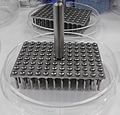Spot analysis
Spot analysis in the context of medical diagnostics is a method used to analyze biological samples for the presence of specific substances or conditions. This technique is often employed in the detection of diseases, monitoring of health conditions, and in the research of biological processes. Spot analysis can involve various types of samples including blood, urine, saliva, and other bodily fluids. The method is valued for its simplicity, speed, and minimal sample requirement, making it a preferred choice in both clinical and research settings.
Overview
Spot analysis typically involves the collection of a small volume of a sample on a specific medium, such as a filter paper, followed by the application of analytical techniques to detect the presence or measure the concentration of an analyte. The analytes of interest can range from metabolites, hormones, proteins, to nucleic acids, depending on the purpose of the analysis. This method is particularly useful in neonatal screening, where it is employed to test newborns for metabolic and genetic disorders using a blood spot obtained via a heel prick.
Techniques
Several analytical techniques can be employed in spot analysis, including but not limited to:
- Chromatography, such as HPLC and GC, which separates compounds based on their physical or chemical properties.
- Mass spectrometry, which identifies compounds based on their mass-to-charge ratio.
- Enzyme assays, which measure enzyme activity or concentration.
- Immunoassays, such as ELISA (Enzyme-Linked Immunosorbent Assay), which detect the presence of antibodies or antigens.
Applications
Spot analysis has a wide range of applications in medical diagnostics:
- Neonatal Screening: Used to screen newborns for a variety of inherited conditions, such as PKU, Cystic fibrosis, and Sickle-cell disease, enabling early intervention.
- Infectious Disease Detection: Employed in the detection of infectious agents, such as viruses and bacteria, in various biological samples.
- Drug Monitoring: Used to monitor therapeutic drug levels in patients, ensuring optimal dosing and minimizing toxicity.
- Metabolic Profiling: Facilitates the analysis of metabolic changes in the body, aiding in the diagnosis of metabolic disorders.
Advantages
Spot analysis offers several advantages over traditional analytical methods:
- Minimal sample volume required, reducing the invasiveness of sample collection.
- Rapid turnaround time, allowing for quick decision-making in clinical settings.
- High sensitivity and specificity, enabling the detection of low-abundance analytes.
- Cost-effectiveness, due to the reduced need for large volumes of reagents and solvents.
Limitations
Despite its advantages, spot analysis also has limitations:
- The quality of the analysis can be affected by the sample collection and handling techniques.
- Limited by the sensitivity and specificity of the analytical method used.
- Not all substances can be effectively analyzed using spot analysis techniques.
Conclusion
Spot analysis is a valuable tool in the field of medical diagnostics, offering a rapid and efficient means of analyzing biological samples for a wide range of applications. Its simplicity, coupled with its ability to provide critical information with minimal sample volume, makes it an indispensable technique in both clinical and research settings.
Transform your life with W8MD's budget GLP-1 injections from $125.
W8MD offers a medical weight loss program to lose weight in Philadelphia. Our physician-supervised medical weight loss provides:
- Most insurances accepted or discounted self-pay rates. We will obtain insurance prior authorizations if needed.
- Generic GLP1 weight loss injections from $125 for the starting dose.
- Also offer prescription weight loss medications including Phentermine, Qsymia, Diethylpropion, Contrave etc.
NYC weight loss doctor appointments
Start your NYC weight loss journey today at our NYC medical weight loss and Philadelphia medical weight loss clinics.
- Call 718-946-5500 to lose weight in NYC or for medical weight loss in Philadelphia 215-676-2334.
- Tags:NYC medical weight loss, Philadelphia lose weight Zepbound NYC, Budget GLP1 weight loss injections, Wegovy Philadelphia, Wegovy NYC, Philadelphia medical weight loss, Brookly weight loss and Wegovy NYC
|
WikiMD's Wellness Encyclopedia |
| Let Food Be Thy Medicine Medicine Thy Food - Hippocrates |
Medical Disclaimer: WikiMD is not a substitute for professional medical advice. The information on WikiMD is provided as an information resource only, may be incorrect, outdated or misleading, and is not to be used or relied on for any diagnostic or treatment purposes. Please consult your health care provider before making any healthcare decisions or for guidance about a specific medical condition. WikiMD expressly disclaims responsibility, and shall have no liability, for any damages, loss, injury, or liability whatsoever suffered as a result of your reliance on the information contained in this site. By visiting this site you agree to the foregoing terms and conditions, which may from time to time be changed or supplemented by WikiMD. If you do not agree to the foregoing terms and conditions, you should not enter or use this site. See full disclaimer.
Credits:Most images are courtesy of Wikimedia commons, and templates, categories Wikipedia, licensed under CC BY SA or similar.
Contributors: Prab R. Tumpati, MD


